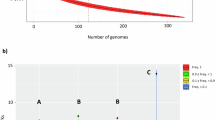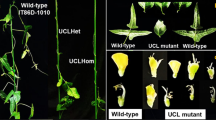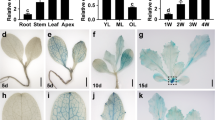ABSTRACT
Recent studies on leaf development demonstrate that the mechanism on the adaxial-abaxial polarity pattern formation could be well conserved among the far-related species, in which PHANTASTICA (PAHN)-like genes play important roles. In this study, we explored the conservation and diversity on functions of PHAN-like genes during the compound leaf development in Lotus japonicus, a papilionoid legume. Two PHAN-like genes in L. japonicus, LjPHANa and LjPHANb, were found to originate from a gene duplication event and displayed different expression patterns during compound leaf development. Two mutants, reduced leaflets1 (rel1) and reduced leaflets3 (rel3), which exhibited decreased adaxial identity of leaflets and reduced leaflet initiation, were identified and investigated. The expression patterns of both LjPHANs in rel mutants were altered and correlated with abnormalities of compound leaves. Our data suggest that LjPHANa and LjPHANb play important but divergent roles in regulating adaxial-abaxial polarity of compound leaves in L. japonicus.
Similar content being viewed by others
Log in or create a free account to read this content
Gain free access to this article, as well as selected content from this journal and more on nature.com
or
References
Bharathan G, Sinha NR . The regulation of compound leaf development. Plant Physiol 2001; 127:1533–8.
Micol J, Hake S . The development of plant leaves. Plant Physiol 2003; 131:389–94.
Bowman JL, Eshed Y, Baum SF . Establishment of polarity in angiosperm lateral organs. Trends Genet 2002; 18:134–41.
Bohmert K, Camus I, Bellini C, et al. AGO1 defines a novel locus of Arabidopsis controlling leaf development. EMBO J 1998; 17:170–80.
Waites R, Selvadurai HRN, Oliver IR, Hudson A . The Phantastica gene encodes a MYB transcription factor involved in growth and dorsoventrality of lateral organs in Antirrhinum. Cell 1998; 93:779–89.
Lynn K, Fernandez A, Aida M, et al. The PINHEAD/ZWILLE gene acts pleiotropically in Arabidopsis development and has overlapping functions with the ARGONAUTE1 gene. Development 1999; 126:469–81.
McConnell JR, Emery J, Eshed Y, et al. Role of PHABULOSA and PHAVOLUTA in determining radial patterning in shoots. Nature 2001; 411:709–13.
Siegfried KR, Eshed Y, Baum SF, et al. Members of the YABBY gene family specify abaxial cell fate in Arabidopsis. Development 1999; 126:4117–28.
Kerstetter RA, Bollman K, Taylor RA, et al. KANADI regulates organ polarity in Arabidopsis. Nature 2001; 411:706–8.
Waites R, Hudson A . Phantastica: a gene required for dorsoventrality of leaves in Antirrhnum majus. Development 1995; 121:2143–54.
Tsiantis M, Schneeberger R, Golz JF, et al. The maize rough sheath2 gene and leaf development programs in monocot and dicot plants. Science 1999; 284:154–6.
Timmermans MCP, Hudson A, Becraft PW, Nelson T . Rough sheath2: A Myb protein that represses knox homeobox genes in maize lateral organ primordia. Science 1999; 284:151–3.
Byrne ME, Barley R, Curtis M, et al. Asymmetric leaves1 mediates leaf patterning and stem cell function in Arabidopsis. Nature 2000; 408:967–71.
Xu L, Xu Y, Dong A, et al. Novel as1and as2 defects in leaf adaxial-abaxial polarity reveal the requirement for ASYMMETRIC LEAVES1 and 2 and ERECTA functions in specifying leaf adaxial identity. Development 2003; 130:4097–107.
Schneeberger R, Tsiantis M, Freeling M, Langdale JA . The rough sheath2 gene negatively regulates homeobox gene expression during maize leaf development. Development 1998; 125:2857–65.
McHale NA, Koning RE . PHANTASTICA regulates development of the adaxial mesophyll in Nicotiana leaves. Plant Cell 2004; 16:1251–62.
Ori N, Eshed Y, Chuck G, et al. Mechanisms that control knox gene expression in the Arabidopsis shoot. Development 2000; 127:5523–32.
Harrison CJ, Corley SB, Moylan EC . Independent recruitment of a conserved developmental mechanism during leaf evolution. Nature 2005; 434:509–14.
Kim M, McCormick S, Timmermans M, Sinha N . The expression domain of PHANTASTICA determines leaflet placement in compound leaves. Nature 2003; 424:438–43.
Lincoln C, Long J, Yamaguchi J, et al. A knotted1-like homeobox gene in Arabidopsis is expressed in the vegetative meristem and dramatically alters leaf morphology when overexpressed in transgenic plants. Plant Cell 1994; 6:1859–76.
Hareven D, Gutfinger T, Parnis A . The making of a compound leaf: genetic manipulation of leaf architecture in tomato. Cell 1996; 84:735–44.
Parnis A, Cohen O, Gutfinger T, et al. The dominant developmental mutants of tomato, Mouse-ear and Curl, are associated with distinct modes of abnormal transcriptional regulation of a Knotted gene. Plant Cell 1997; 9:2143–58.
Janssen BJ, Lund L, Sinha N . Overexpression of a homeobox gene, LeT6, reveals indeterminate features in the tomato compound leaf. Plant Physiol 1998; 117:771–86.
Hofer J, Gourlay C, Michael A, Ellis TH . Expression of a class 1 knotted1-like homeobox gene is down-regulated in pea compound leaf primordia. Plant Mol Biol 2001; 45:387–98.
Bharathan G, Goliber TE, Moore C, et al. Homologies in leaf form inferred from KNOXI gene expression during development. Science 2002; 296:1858–60.
Koltai H, Bird DM . Epistatic repression of PHANTASTICA and class I KNOTTED genes is uncoupled in tomato. Plant J 2000; 22:455–9.
Kim M, Pham T, Hamidi A, et al. Reduced leaf complexity in tomato wiry mutants suggests a role for PHAN and KNOX gene in generating compound leaves. Development 2003; 130:4405–15.
Hofer J, Turner L, Hellens R, et al. UNIFOLIATA regulates leaf and flower morphogenesis in pea. Curr Biol 1997; 7:581–7.
Taylor S, Hofer J, Murfet I . Stamina pistilloida, the Pea Ortholog of Fim and UFO, is required for normal development of flowers, inflorescences, and leaves. Plant Cell 2001; 13:31–46.
Tattersall AD, Turner L, Knox MR, et al. The Mutant crispa Reveals Multiple Roles for PHANTASTICA in Pea Compound Leaf Development. Plant cell 2005; 17:1046–60.
Hall TA . BioEdit: a user-friendly biological sequence alignment editor and analysis program for Windows 95/98/NT. Nucl Acids Symp Ser 1999; 41:95–8.
Thompson JD, Gibson TJ, Plewniak F, et al. The CLUSTALX windows interface: flexible strategies for multiple sequence alignment aided by quality analysis tools. Nucleic Acids Res 1997; 25: 4876–82
Page RDM . TREEVIEW: An application to display phylogenetic trees on personal computers. Comput Appl Biosci 1996; 12: 357–8.
Alvarez J, Guli CL, Lu XH, Smyth DR . Terminal flower: a gene affecting inflorescence development in Arabidopsis thaliana. Plant J 1992; 2:103–16.
Jackson D, Veit B, Hake S . Expression of maize KNOTTED1 related homeobox genes in the shoot apical meristem predicts patterns of morphogenesis in the vegetative shoot. Development 1994; 120:405–13.
Bradley D, Carpenter R, Sommer H, et al. Complementary floral homeotic phenotypes result from opposite orientations of a transposon at the plena locus of Antirrhinum. Cell 1993; 72:85–95.
Theodoris G, Inada N, Freeling M . Conservation and molecular dissection of ROUGH SHEATH2 and ASYMMETRIC LEAVES1 function in leaf development. Proc Natl Acad Sci U S A 2003; 100:6837–42.
Nakamura Y, Kaneko T, Asamizu E, et al. Structural analysis of a Lotus japonicus genome. II Sequence features and mapping of sixty-five TAC clones which cover the 6.5 Mb regions of the genome. DNA Res 2002; 9:63–70.
Perry JA, Wang TL, Welham TJ, et al. A tilling reverse genetics tool and a web-accessible collection of mutants of the legume Lotus japonicus. Plant Physiol 2003; 131:866–71.
Zhang J . Evolution by gene duplication: an update. Trends Ecol Evol 2003; 18:292–8.
Doebley J, Stec A, Hubbard L . The evolution of apical dominance in maize. Nature 1997, 386:485–8.
Wang RL, Stec A, Hey J, Lukens L, Doebley J . The limits of selection during maize domestication. Nature, 1999, 398:236–9.
Acknowledgements
The authors thank Dr. Hai HUANG for the vectors used in Arabidopsis transformation, and Dr. Bernard J. CARROLL for helpful revision. This research was financially supported by the National Natural Science Foundation of China (Grant No. 30430330).
Author information
Authors and Affiliations
Corresponding author
Rights and permissions
About this article
Cite this article
LUO, J., YAN, J., WENG, L. et al. Different expression patterns of duplicated PHANTASTICA-like genes in Lotus japonicus suggest their divergent functions during compound leaf development. Cell Res 15, 665–677 (2005). https://doi.org/10.1038/sj.cr.7290336
Received:
Revised:
Accepted:
Issue date:
DOI: https://doi.org/10.1038/sj.cr.7290336
Keywords
This article is cited by
-
Genetic control of compound leaf development in the mungbean (Vigna radiata L.)
Horticulture Research (2019)
-
Auxin transport inhibitor induced low complexity petiolated leaves and sessile leaf-like stipules and architectures of heritable leaf and stipule mutants in Pisum sativum suggest that its simple lobed stipules and compound leaf represent ancestral forms in angiosperms
Journal of Genetics (2013)
-
Duplication of the Asymmetric Leaves1/Rough Sheath 2/Phantastica (ARP) gene precedes the explosive radiation of the Ruschioideae
Development Genes and Evolution (2009)
-
Characterization of KNOX genes in Medicago truncatula
Plant Molecular Biology (2008)



